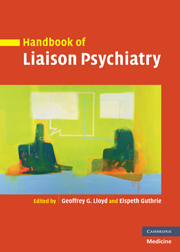Book contents
- Frontmatter
- Contents
- List of contributors
- Preface
- Part I Basic skills
- Part II Common psychiatric problems across the general hospital
- Part III Working with specific units
- 14 Neurological disorders
- 15 Cardiorespiratory disorders
- 16 Gastrointestinal disorders
- 17 Liver disorders
- 18 Endocrine disorders
- 19 Diabetes
- 20 HIV and AIDS
- 21 Renal disease
- 22 Musculo-skeletal disorders
- 23 Oncology
- 24 Head and neck cancer
- 25 Palliative care
- 26 Cosmetic procedures
- 27 Perinatal and gynaecological disorders
- 28 The intensive care unit
- 29 The burns unit
- 30 Psychocutaneous disorders
- 31 Genitourinary disorders
- 32 The emergency department
- Part IV Treatment
- Part V Different treatment settings
- Index
- References
29 - The burns unit
from Part III - Working with specific units
Published online by Cambridge University Press: 10 December 2009
- Frontmatter
- Contents
- List of contributors
- Preface
- Part I Basic skills
- Part II Common psychiatric problems across the general hospital
- Part III Working with specific units
- 14 Neurological disorders
- 15 Cardiorespiratory disorders
- 16 Gastrointestinal disorders
- 17 Liver disorders
- 18 Endocrine disorders
- 19 Diabetes
- 20 HIV and AIDS
- 21 Renal disease
- 22 Musculo-skeletal disorders
- 23 Oncology
- 24 Head and neck cancer
- 25 Palliative care
- 26 Cosmetic procedures
- 27 Perinatal and gynaecological disorders
- 28 The intensive care unit
- 29 The burns unit
- 30 Psychocutaneous disorders
- 31 Genitourinary disorders
- 32 The emergency department
- Part IV Treatment
- Part V Different treatment settings
- Index
- References
Summary
Introduction
Burn trauma is a significant cause of mortality and morbidity. In 1999 192 males and 144 females died as a direct result of burn trauma in England and Wales (Office for National Statistics 2000). Frank et al. (1987) estimated that 731 000 emergency room visits and 60 900 hospital admissions occurred annually as a result of burn trauma in the USA. Wilkinson (1998) obtained data from six of the nine accident and emergency departments (AED) that served a UK population of 2.6 million. There were 3013 attendances as a result of burn trauma over a 1-year period representing 1% of the total AED workload.
It is no surprise that burn trauma can result in psychological distress. The burn trauma victim has many issues to contend with. Stressors often include the burn injury itself, pain, hospitalization, reduced functioning and permanent scarring. In addition the burn injury has often been sustained as a result of involvement in a frightening psychologically traumatic event. Individuals who sustain burn trauma also appear more likely to have pre-existing mental health difficulties than the general population (e.g. Patterson et al. 1993).
Nature and prevalence of psychiatric sequelae following burn trauma
Several authors and researchers have considered the psychological impact of burn trauma. The earliest studies were mainly descriptive in nature. Overall, the methodology employed has improved over time. The most recent studies have used well-validated measures to determine the presence of psychological sequelae although unfortunately, like the older studies, have relatively small sample sizes.
- Type
- Chapter
- Information
- Handbook of Liaison Psychiatry , pp. 697 - 713Publisher: Cambridge University PressPrint publication year: 2007



